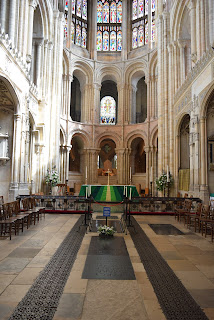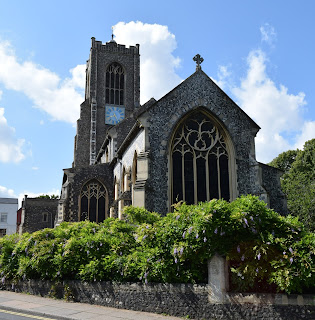Today (Tuesday, August 10th) we didn’t travel as far as on other days of the holiday but walked further than we had any of those days as we explored the City of Norwich.
Norwich, with its castle, two cathedrals and multiple Churches is worth
exploring. While we have been in the city twice before on this holiday, we had
set today aside to really explore this city at the heart of East Anglia.
Breakfast
I was again up at 5.30am, it seems a perfect time for me, I had breakfast and then started on the lengthy blog of the day in Bury St. Edwards, Lavernum and Thetford, itself a very busy day. Given the need to shower and
shave etc. I didn’t get time to finish the blog post but had made a good start on it
by the time we left for Norwich at 9.30am.
The trip into the city was uneventful and we parked at our
usual car park at 10am.
History
Castle
At the centre of Norwich high on its hill stands a Castle like no other Castle I’ve seen in the UK. It is shaped like a big, window free, box. Oddly the Castle at Norwich was built without being needed for defence and apart from the formal use by the Sheriff of the city it wasn’t even where the Kings and Queens who visited the City chose to stay. Thus, it has a more decorative than functional use. By 1883 having spent some time as the County Jail it had become a Museum, which it continues to be today.
Unfortunately, due to a major renovation going on in the Castle we weren’t able to visit the battlements and see over the city from there. The bit of the castle that was open was the Museum which has NationalHistory and Art exhibits. There are many impressive paintings by local and international artists. Perhaps my favourite was one of the City itself (look at the horizon where you can see the shape of the castle, cathedral and another church) with a pastoral scene in the foreground.
The only historical parts of the museum being about the Iceni and the Romans, rather than about the history of the City of Norwich. Which I felt was a bit disappointing. Some of the ancient artefacts were attractive, Drew was especially taken by the ring below which seemed very Tolkien like to him.
Cathedral
From the Castle we walked down to the Cathedral, passing
another iconic Norwich site the studios of Anglia Television where for decades
Sale of the Century was broadcast to the nation with the reliable charm of Nicholas
Parsons, best known to me for his role as chair of Just a Minute for 60 years.
We entered the Cathedral grounds through one of four intact gates.
The grounds are open and airy and many people were taking advantage of the
great weather to have a picnic.
The West Door of the Cathedral remains a magnificent site
after all these centuries and the statues of Dame Julian of Norwich and St.
Benedict are very prominent.
Must of the excitement around the Cathedral today was of people visiting the ‘Dippy the Dinosaur’ exhibition. The pretend dinosaur skeleton, for long the preserve of the Natural History Museum in London, is now travelling through the country on a tour having been replaced in London by the actual skeleton of a whale. [Co-pilot's note: Chunter, chunter, poor old Dippy, I'd like to see you calling him that to his face.]
The queue for Dippy was enormous, but we were lucky
to be able to avoid it and go into the South Entrance of the Cathedral and see
the top end of the Church (but not see the Nave as that is where Dippy was
being displayed).
The Cathedral has an amazing range of stained glass and that will go up on to Flickr on Sunday or Monday Evening depending on timing this weekend.
Tombland
The area of Norwich outside the Cathedral is known as Tomband
which is also the name of the book which first got my interested in the city. The name is not about graves, but is the old English for Open Ground or Empty Land and donates the Market area that was outside the Cathedral in Norman times.
The houses of the wealthy merchants from the time when Norwich was the second
biggest City in England, after London, are all represented in this area.
St. Julian of Norwich
After the Cathedral we went to visit the shrine to DameJulian of Norwich. I was lucky enough to be introduced to her wonderful little book ‘Revelations of Divine Love’ in my late teens.
Dame Julian, an anchoress (a female hermit who
lives in an anchorite next to a Church), had a deep and abiding love for Jesus
which inspired her to give her whole life to her Lord as an act of faith. Her inspiration
like those of later religious women like Teresa of Avila, Therese of Lisieux
and Faustina Kowalska is about coming to know Jesus in an absolutely
personal way through a deep and abiding love for him, whose love for us exists
before we are created. It is humbling for me to sit in the space where Dame
Julian gave her whole life to love of God and her neighbour, to hope and pray
that I can have a scintilla of that same love for Jesus whose love for me has
been so abundant throughout all of my life.
St. Stephen’s Church
Moving back from St. Julian’s Church, which is on the edges
of the City Centre, into the City Centre we came to St. Stephen’s Church which
is beside the most recent shopping developments in the city.
The Church grounds form a perfect place for people to gather
on this glorious sunny day with the temperature at 24 degrees Celsius.
The inside of the Church is less full of ornament than some
of the places we have visited, but it was interesting to find that in the Middle
Ages it was the centre of pilgrimage for one of its former clergy – Richard Caister
– who served the people of his parish with unusual simplicity and fervour (to
be clear I mean unusual for that time.)
St. Giles Church
From St. Stephen’s we travelled up the City to St. Giles' Church which
can be seen from distances around due to its position on the hill to the west
of the city. While the Church was locked, we appreciated its size.
Drew particularly liked its gargoyles, especially this
fella:
The Catholic Cathedral
Just up the road from St. Giles is the Catholic Cathedral ofSt. John the Baptist. This Cathedral for the Diocese of East Anglia was built in the 1880s
as a Parish Church. Its style is remarkably different from most Gothic churches
and cathedrals of its time. Taking a more traditional English approach to
architecture rather than the pan-European influence seen in the works of both
Pugins in many Cathedrals in England and Wales, like St. Chad’s, Birmingham and
St. Joseph’s, Swansea.
The Cathedral Treasury is on display
It was lovely to have time to sit and pray in the Blessed Sacrament chapel while Drew took photos of stained glass and statues for loading on Flickr later this week.
Chickens
After we finished our visit, we left Norwich at 4pm (a six-hour visit, wow) and drove out to Attleborough for another visit to Robin and Liz Croft. We sat in a lovely, shaded outdoors and enjoyed some cool after the sunny heat of the day. Drew spent time visiting the hatchlings which had pecked their way out of their shells this morning and really enjoyed seeing them.
Dinner
We had originally planned to eat this evening at the Tipsy Vegan in Norwich, however early this afternoon I got a call from them to say they have had to close due to a staff member having a positive PCR test for Covid.
Robin and Liz had put their thinking caps on and by the time we got out to them
in late afternoon they had managed to book dinner for 7:45pm at the White Lodge
in Attleborough.
The White Lodge is a pub and restaurant on the old Norwich
to London Road which now runs parallel here to the A11. It has been refurbished
recently and has a large, barn like, restaurant space, which was full apart from
the table booked for us, when we arrived.
The menu is eclectic but included lots of things we like. Drew began with Whitebait
I had Chicken Wings in Smoky Hickory BBQ Sauce which were sticky and lovely.
Robin and Liz shared a Baked Camembert plate together.
Drew’s main was a venison burger which came served with
lettuce, tomato and pickle and a red cabbage and apple coleslaw and chunky
chips.
For mains I had a Warm Goat’s Cheese Salad with two generous
pieces of goat’s cheese and a lovely fresh salad drizzled with a sticky balsamic
vinegar, wonderful.
Robin also went for a burger, but a spiced halloumi one in
his case.
Liz opted for the Salmon with roasted potatoes and vegetables
and a rocket salad.
We were all very happy with our respective meals.
For dessert Drew had what turned out to be a huge Wild Berry Eton Mess and Liz had Caramel Crunch cheesecake with Popcorn.
After a lovely meal and catch-up we dropped Liz and Robin back
to their home at 9:50pm and for back to Wagtail Barn at 10:30pm.
Like many days on this holiday it was a long yet enjoyable and fulfilling day.




























There are lots of interesting buildings in Norwich and I very much enjoyed your outline of the history of the city.
ReplyDeleteSurprised there’s no mention of the open market!
How remiss of me. It came between St. Stephen's and St. Giles. The cheesemonger had an especially good range.
DeleteA nice evening, and a great meal, Haydn, thank you! I'm glad you managed to get my White Rabbit embroidered t-shirt in the photo. Thank you also for more enlightenment on Julian of Norwich, to whom I have mistakenly been referring to as 'Saint', rather than 'Dame' or 'Mother'.
ReplyDeleteHi Robin,
DeleteThe t-shirt was a must, what amazing work Liz had been doing. More professional than the professionals.
As regards Dame Julian, you weren't wrong to call her St. Julian of Norwich, she has been canonised. The problem lies with the fact that there are three other St. Julian's including the one for which the Church where Dame Julian lived, and from which she took her name (as was the tradition for Anchoresses). The Church of St. Julian in Norwich seems to be dedicated to St. Julian of Le Mans - https://en.wikipedia.org/wiki/Julian_of_Le_Mans - Le Mans is where King Henry the Second was born so devotion to this saint came to England at that time which would fit with the Norwich link.
It is possible that the Julian in question is St. Julian the Hospitaller, often known as St. Julian of Malta - https://en.wikipedia.org/wiki/Julian_the_Hospitalle - he was also a popular saint amoung the Norman and other European nobility.
For certain it isn't named for the St. Julian with which I am most familiar (other than Dame Julian) i.e. St. Julian of Caerleon who along with Aaron and Alban were the first Christian Martyrs on this island - https://en.wikipedia.org/wiki/Julius_and_Aaron - I say this dedication is unlikely as Julian (also known as Julius) and his confreres were Roman British stock, so far less likely to be associated with Norman churches than the two continental Julians!!